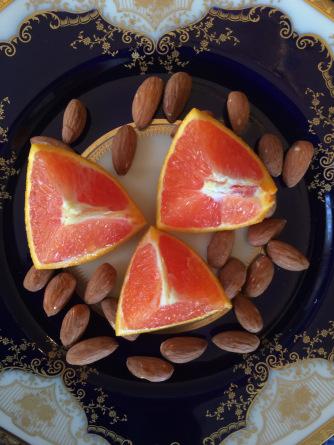
Tu Bishvat Photo: Susan Katz Miller
Last weekend, my husband and I celebrated Tu BiShvat, the Jewish new year of the trees. We sang songs about trees in Hebrew, said blessings over fruits of the trees, and shared grape juice, almonds, and dates in a Tu BiShvat seder meal. We sat at long tables filled with small children, parents, and grandparents, from the Interfaith Families Project of Greater Washington DC. We are a community of over 200 families led by a minister and a rabbi, working together to honor both of our family religions.
When I got back home, I noticed a new article sent out by the Jewish Telegraphic Agency (JTA) entitled “Outside the synagogue, intermarried are forming community with each other.” First, as always, I had to recover from the jarring language (which included repeated use of the term “non-Jew”). I’m sad to report that my recent article in the Forward, explaining all the problems with the word “intermarriage,” has not had a broad impact. I do not consider myself “intermarried.” For three generations, my family has used the term “ interfaith family,” and I love how this allies us with everything positive about interfaith activism, bridge-building, and peacemaking.
But anyway, after looking past the language in this article, I appreciated that the reporter seems to have understood that interfaith families are tired of being disrespected by traditional religious institutions, and by programming that implicitly privileges “inmarried” couples and conversion. He hinted at the yearning many of us in interfaith families feel to control our own narratives, and to engage with religion in a way that will support the whole family.
And yet, all the programs described by the reporter in this article are supported exclusively by Jewish institutions, and most are created and/or led by rabbis or other Jewish educators. Nowhere does this piece explore how the Christian (or Buddhist or Hindu) partners feel about the fact that they are still expected to learn about Jewish ideas and practice, without any reciprocation. Meanwhile, the reporter ignored programs that provide interfaith education for interfaith families. He ignored independent communities formed by and for interfaith families, with balanced leadership, including thriving communities like mine.
And yet, we had hundreds of people at our celebration of Tu BiShvat on Sunday immersed in Jewish learning, discussing the Kabbalists and the mystical meaning of trees, and brainstorming how to become a greener community. Sometimes, this is what it looks like when a community of interfaith families designs their own programming. I wish more well-intentioned religious educators, clergy, and reporters would come and actually take a look.
Susan Katz Miller is the author of Being Both: Embracing Two Religions in One Interfaith Family, from Beacon Press. She works as an interfaith families consultant, speaker, and coach. Follow her on twitter @susankatzmiller.

